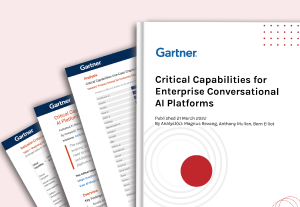- Artificial Intelligence, Conversational Design, Customer Experience, Design, Usability, UX Education, UX Magazine, UX World Changing Ideas
Take a deep dive into Gartner’s evaluation of the most important attributes of enterprise conversational AI platforms for customer service from their new Critical Capabilities report. We’ve also got learnings from the top ranked platform’s real-world orchestration of conversational AI, which allowed one national retailer to prop up a new call center and cut their inbound traffic by 50% in just ten weeks.
Article by UX Magazine Staff
Rewriting Customer Service with Conversational AI
- Conversational AI is an inevitable market state and enterprises are in hot pursuit of platforms that will enable them to successfully orchestrate the associated technologies—like NLU/NLP, code-free design, RPA, and machine learning. Gartner’s 2022 Critical Capabilities for Enterprise Conversational AI Platforms report is the first of its kind, providing a comprehensive breakdown of the technical requirements for entering this new paradigm for productivity.
- The best way to succeed in customer service applications of conversational AI is by incorporating a broad range of channels (touching on every possible way a customer might try to engage with a business) as part of an open system that allows for integration with tools and solutions from other vendors and involves human agents in its operation and evolution.
- Flexible open platforms allow businesses to rapidly identify and capitalize on the massive opportunities conversational AI brings while adapting their own operations around the fluctuating nature of the associated technologies. In essence, future-proofing their operations.
- The highest-ranking company in the Customer Service Use case was OneReach.ai. Using their platform for conversational AI, a large national retailer was able to create a new call center and cut their inbound traffic by half in just 10 weeks.
Share:Rewriting Customer Service with Conversational AI
Share this link
- June 10, 2022
7 min read







